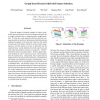Free Online Productivity Tools
i2Speak
i2Symbol
i2OCR
iTex2Img
iWeb2Print
iWeb2Shot
i2Type
iPdf2Split
iPdf2Merge
i2Bopomofo
i2Arabic
i2Style
i2Image
i2PDF
iLatex2Rtf
Sci2ools
ICDM
2008
IEEE
2008
IEEE
Graph-Based Iterative Hybrid Feature Selection
When the number of labeled examples is limited, traditional supervised feature selection techniques often fail due to sample selection bias or unrepresentative sample problem. To solve this, semi-supervised feature selection techniques exploit the statistical information of both labeled and unlabeled examples in the same time. However, the results of semi-supervised feature selection can be at times unsatisfactory, and the culprit is on how to effectively use the unlabeled data. Quite different from both supervised and semi-supervised feature selection, we propose a “hybrid” framework based on graph models. We first apply supervised methods to select a small set of most critical features from the labeled data. Importantly, these initial features might otherwise be missed when selection is performed on the labeled and unlabeled examples simultaneously. Next, this initial feature set is expanded and corrected with the use of unlabeled data. We formally analyze why the expected pe...
Data Mining | Feature Selection | Feature Selection Techniques | ICDM 2008 | Semi-supervised Feature Selection |
Related Content
| Added | 30 May 2010 |
| Updated | 30 May 2010 |
| Type | Conference |
| Year | 2008 |
| Where | ICDM |
| Authors | ErHeng Zhong, Sihong Xie, Wei Fan, Jiangtao Ren, Jing Peng, Kun Zhang |
Comments (0)

